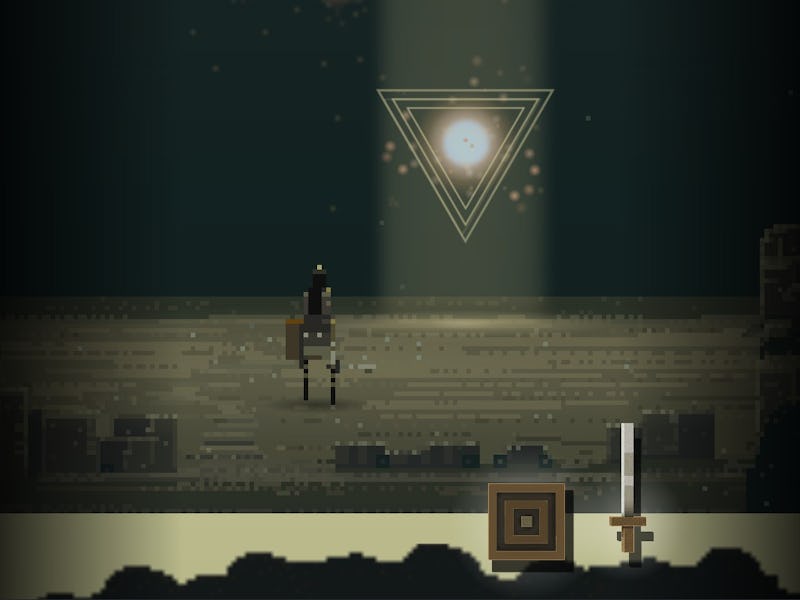Sword & Sworcery’s Steam Deck Update Makes Its Unique Adventure Better Than Ever
Complete your woeful errand.

It may not feel like that long ago, but 2011 was practically another lifetime ago in the world of video games. With the Wii U, PS4, and Xbox One still distant blips on the radar, the indie scene as we know it was just starting to get the attention of players and publishers, and iOS gaming was in its infancy. Outside of gaming, Twitter was still fairly new, yet to begin its transformation from communication platform to the nightmare bog of hate speech and AI garbage it is today.
Into this landscape entered Superbrothers: Sword & Sworcery EP. Yes, that’s how it’s spelled.
At its core, Sword & Sworcery is a point-and-click game — or, as it launched on iPad, a poke-and-tap game. It follows a character known only as the Scythian on her “woeful errand,” which isn’t super well explained at first, but involves collecting a grimoire called the Megatome and a handful of glowing triangles to bring about the “time of miracles.”
Superbrothers: Sword & Sworcery is a cult classic you need to experience for yourself.
The first thing you’ll probably notice about Sword & Sworcery is its gorgeous pixel art. The second is its equally astounding synth soundtrack. But the third thing — here’s where it gets really interesting — is its tone. While its tropey, fuzzy-around-the-edges premise might imply a samey, self-serious fantasy tale, Sword & Sworcery is anything but.
It’s a genre-bending, fourth wall-breaking, ironically detached experiment that maintains a somewhat self-mocking tone without losing any of its narrative punch. Even now, I blame Sword & Sworcery at least a little bit for my love of writing long, meandering sentences and undercutting crisp lines of prose with jokes and overly casual phrases.
As the “EP” tacked onto its moniker might suggest, Sword & Sworcery is structured something like an album. It’s broken into four “sessions,” which take you through the Scythian’s journey with kind of frustrating combat that requires blocking and striking to rhythm, and some pretty esoteric puzzles. If you’re not the type to just tap on everything on the screen to find a solution, there’s no shame in playing Sword & Sworcery with a walkthrough.
After each session, you’re booted back to the menu to speak to a character called the Archetype. This besuited, cigar-chomping character delivers monologues on what’s happening in the game and encourages you to take a break between sessions, which together take three to four hours to complete.
Sword & Sworcery tells an epic tale with a sense of humor.
Well, three to four hours, give or take a month. One of Sword & Sworcery’s more challenging elements is that certain parts of the game can only be completed at the right point of the lunar cycle. That is, our real-world lunar cycle. There are cheats to get around this, but playing the game the “correct” way means setting it aside, sometimes for weeks, until the Moon hits the right point for the story to proceed.
Another of its little experiments involves the more terrestrial force of Twitter. When the game launched, it included a little button you could click at any time to tweet whatever pithy bit of text was displayed on screen at the time. Sword & Sworcery’s writing has a particular cadence to it, careening wildly from poetic to sardonic and silly in the same sentence, that made pressing that button feel irresistible.
I once used this feature multiple times during a short play session (tweeting things like “We spied the solitary grave at the edge of the perilous precipice & we wondered what was up with that”), and spent the evening texting worried friends with assurances that my account hadn’t been hacked. Given the state of social media for the past few years, this feature was removed for a 2018 Switch port, replaced with an in-game message noting, “since our prior experiment in 2011, social networks have proven to be catastrophic for society.”
Nothing else comes close to Sword & Sworcery’s vibe.
I glossed over Sword & Sworcery’s art and music earlier, but they’re just as important to the game as its writing. More than a decade later, Sword & Sworcery still has some of the most impressive pixel art I’ve ever seen. Its lush forests and rocky mountains are rendered in agonizing detail, and you can swap from a tight, zoomed-in shot to a distant view that reduces the Scythian to a tiny figure in the frame. Its characters have a lanky style that looks like no other game. On top of that are eye-catching lighting effects and tiny details like rabbits skittering through the forest that bring its strange setting to life.
Composed by Jim Guthrie, Sword & Sworcery’s soundtrack is iconic. From dark and moody to gently uplifting, it brings the player on an emotional journey to match the Scythian’s grave task, its synths somehow matching the strange wilderness of the game’s world perfectly. Long after you’ve completed the game, its soundtrack is all but guaranteed to keep bouncing around in your head.
So why should you play this oddity of a game now, even with its charming Twitter integration removed? Well, in mid-November, publisher Capybara Games updated Sword & Sworcery to add compatibility and fixes for all its platforms. Among other things, it’s now playable on the latest version of MacOS and on Steam Deck, and it’s on sale for a mere three dollars until November 28. I highly recommend playing on one of Valve’s sought-after handhelds, with the game’s beautiful little pixels up close to your eyeballs and its soundtrack ideally pumping through headphones. More than 12 years after its first release, there’s still nothing else like it.
Superbrothers: Sword & Sworcery EP is available now on Nintendo Switch, PC, and mobile devices.
This article was originally published on